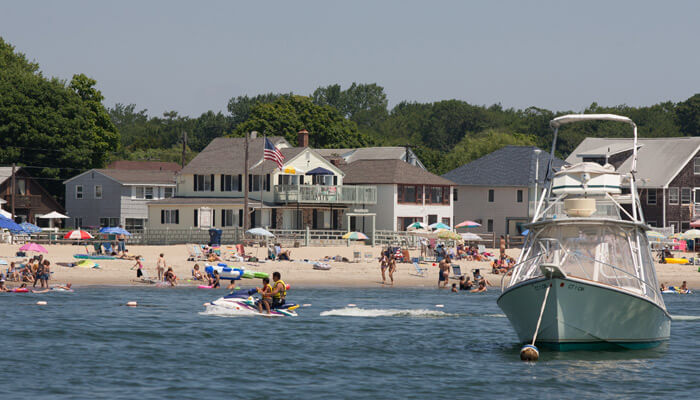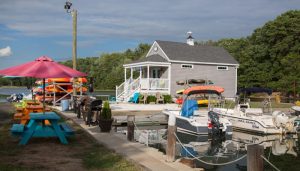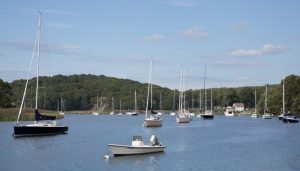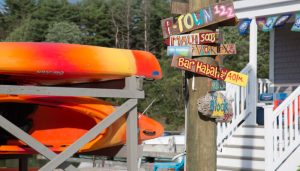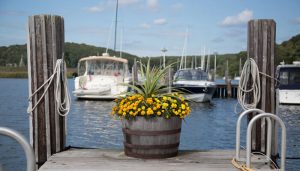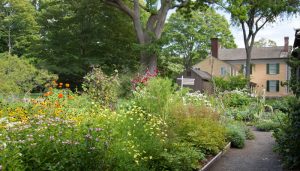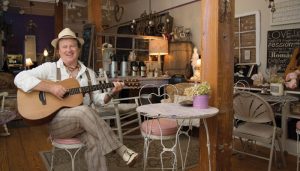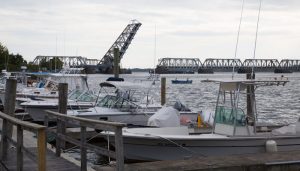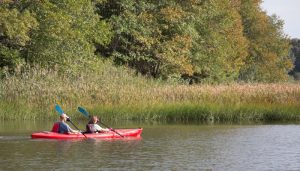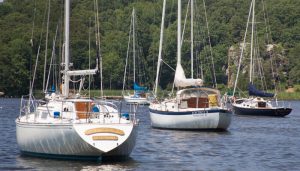
South Portland Boat Launch Closed Until 2026
June 3, 2025
Damariscotta Lake Story
June 6, 2025
Welcome to Old Lyme
Long a haven for artists, nature-lovers, and boaters seeking peace and tranquility, Old Lyme is a rare find along the heavily traveled Connecticut coast.
OLD LYME'S STORY
Shhhh…You’re approaching Old Lyme, passing Saybrook Light on Long Island Sound, making your way past the breakwater, throttling back to obey the no-wake zone. Steering east, you skirt salt marshes that sweep like the Kansas prairie. Amid the waving blades of spartina and towering reeds, birds chatter and squawk. They are the loudest things in this tranquil place.
Morning mist rising from the river creates the hazy tableau of an impressionist painting: a blurred, muted landscape in the very place considered the birthplace of American Impressionism. It was here, in the late 1890s, that widow Florence Griswold opened her home to American artists fresh from studying in France, forming the country’s first European-style artist colony—an “American Giverny.”
Today, the creative-minded and those who appreciate their work still find their way to this exquisite slice of coastal Connecticut midway between New York and Boston.
With a population of nearly 8,000, the 27 square miles of Old Lyme comprise a triangle of land where Long Island Sound meets the Connecticut River. Tidal creeks wind through the surrounding marshland, providing important habitat for many species of birds and fish.
It’s an ephemeral place where nature plays havoc with sandbars and islands, carving random compositions with each storm. What is one day a deep channel is a beach the next. It’s the main reason Old Lyme never became a commercial port, and why the town has long been appreciated by sportsmen, artists, and nature-lovers.
All three types frequently gather along the wooden boardwalk that skirts the river near the Amtrak railroad bridge. Constructed by the state’s Department of Energy & Environmental Protection, the quarter-mile platform starts at the DEEP Marine Division Headquarters parking lot, passes below the bridge, and ends at a salt marsh teeming with birds. Visit the place on a late afternoon and you’ll see why so many folks are drawn to this peaceful spot.
Of course, an even better way to experience the wild side of Old Lyme is in your own boat or kayak. Depending on your draft, you can hook east of Great Island and into the winding Lieutenant River, where egrets, herons, osprey, cormorants, terns, and other birds dip and dive, play hide-and-seek amid the reeds, or soar overhead.
Just north of Griswold Cove, the Black Hall River meets the Lieutenant. Following the former will bring you to Black Hall Marina, which is popular among center-console anglers and home to a well-stocked tackle store and paddlesports outfitter. Black Hall also rents kayaks and paddleboards, and offers guided trips.
Given the abundant bird life in and around the mouth of the Connecticut River and its various tributaries, it’s no surprise that Roger Tory Peterson, our modern-day Audubon, made his home in Old Lyme. After the ornithologist’s death in 1996, Great Island—the huge swath of marsh at the mouth of the Connecticut—was renamed the Roger Tory Peterson Wildlife Area. Today, Great Island hosts one of the largest osprey nesting colonies on the East Coast.
From its mouth at the tip of Great Island, the Lieutenant River stretches several miles north, where it connects with the small Duck River via a small side channel just south of the railroad bridge. The Duck, as well as the Back River, are extremely shallow and, like the Lieutenant, suitable only for skiffs and kayaks.
Back on the main stem of the Connecticut, heading north, the first marina you’ll come to is the small Old Lyme Dock Company, between the railroad bridge and Interstate 95, about three miles from the Sound. There are no indications, from the road at least, that this is anything other than private property, save for a towering Shell gasoline sign. Surprisingly, the unassuming little marina offers the cheapest fuel on the river, making it a popular stop for many boaters in the area.
Just north of the I-95 bridge is the full-service Old Lyme Marina, with slips and moorings in a beautiful cove tucked behind Calves Island. It’s a bit closer to town and a short walk from the place that put Old Lyme on the map: the Florence Griswold Museum, now a multi-acre complex encompassing Griswold’s Georgian-style main house, a modernist gallery, a barnlike studio, the seasonal Café Flo, and acres of gardens and plantings set on the Lieutenant River.
In 1899, to keep from losing her home after the death of her husband, 50-year-old Florence Griswold began renting rooms to artists drawn to the brilliance and clarity of light in Old Lyme. Childe Hassam, Henry Ward Ranger, and dozens more moved in, creating America’s first Impressionist art colony and paying their hostess back by creating murals on her paneling, cupboards, and doors. Visitors can see these well-preserved paintings on a house tour, then ogle a changing art collection in the modern Krieble Gallery. It’s easy to spend the better part of a day here, especially if you come on Sundays in season when, wearing a smock and straw hat provided by the museum, you’re dispatched with painter’s palette and blank canvas to the marshy banks of the river to create en plein air, just as the Impressionists did.
Florence Griswold’s boarders spurred a quiet revolution in Old Lyme. The artists needed a place to exhibit their work, so in 1921, members of the newly established Lyme Art Association opened a gallery next door. Today, this weathered New England structure remains a marvel of soaring sunlit rooms ideal for artwork display.
Members of the Association—both artists and supporters—ensure that the organization’s shows and programs continue to evolve. Down the street, around 200 students from all over the world attend the Lyme Academy College of Fine Arts, which was founded in 1976 in the basement of the LAA gallery.
If all this art immersion entices you to drop a few grand on a classic painting or sculpture, the Cooley Gallery has you covered. It’s located on Lyme Street, where you’ll also find the Old Lyme Inn, which has been making waves since 2013 when it opened a jazz club called The Side Door. It’s also one of the few places to spend the night in town.
From the Historic District, as you walk back to the Old Lyme Marina on Halls Road (Route 1), be sure to stop by Bowerbird, a gift emporium so famous and expansive that people come from out of state to pick up everything from home goods to jewelry to pet items to baby gifts.
Of course, you can also simply sit on the banks of the Lieutenant River and take in the quiet beauty and magical light that first attracted American artists to Old Lyme over a century ago.
OLD LYME GALLERY
Written by Malerie Yolen-Cohen
Malerie is Co-Publisher of Northeast travel website GetawayMavens.com, and she is the author of the cross-country travel guide, Stay On Route 6; Your Guide to All 3562 Miles of Transcontinental Route 6. She has written for National Geographic Traveler, Ladies Home Journal, Yankee Magazine, Shape.com, Sierra Magazine, and dozens of other publications.
Photographed by Caryn B. Davis
Caryn has specialized in architecture, interiors, and landscape design photography for 25 years. She is a creative collaborator, art lover, beauty seeker, a journalist, and a faithful student and traveler of the world. She has produced 3 photography books (Connecticut Waters, A Connecticut Christmas, and Connecticut Gardens), and has contributed to a long list of regional and national publications including New England Boating. Visit her website Caryn B. Davis Photography to view her work and accomplishments.


